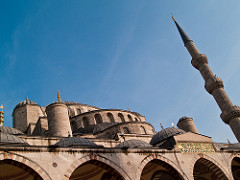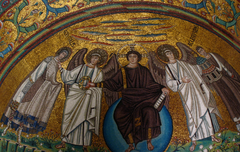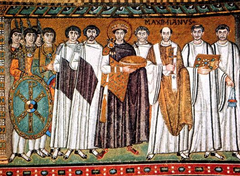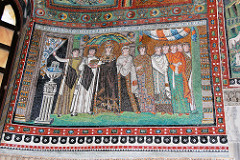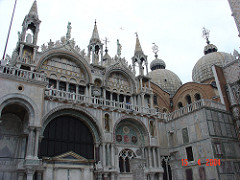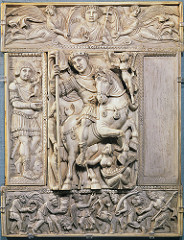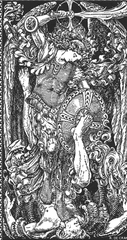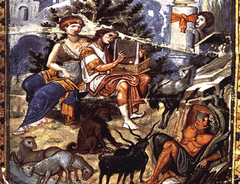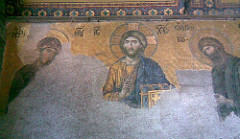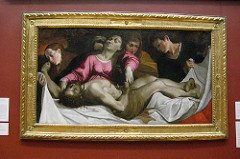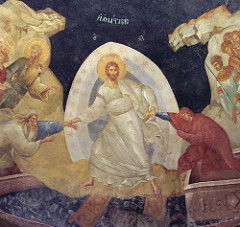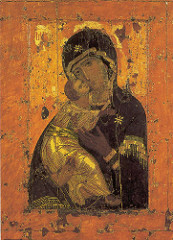Hagia Sophia, Constantinople 532. Original domes collapsed. Minarets were later addition. Means "Church of the Holy Wisdom". Built by two mathematicians, Anthemius of Tralles & Isidorus of Miletus. Justinian wanted to built the greatest church ever. Original dome was 108 ft diameter. Large building made of brick to make building distinguished from concrete Roman buildings. Originally a Christian church, then a mosque, now a museum. Plain exterior, lavish interior. Incredible light. Longitudinal and central plan. Dome rests on pendentives; weight then goes to piers not walls, then the space below the dome is un-obstructed. Only Emperor and High Priest allowed to enter sacred places in the church- apse, altar; shows unification of Church and State. Conches: semi-domes on either side of central dome. alter at end of nave. dome supported by pendentives. window acts as a halo. cornice unifies space.centrally planed apse with longer basilica axially planned nave facing an alter.
Virgin (Theotokos) and Child enthroned
From Hagia Sophia. Has nimbus. Flat, simple to show the story. Icon and symbolism to show the characters.Drapery is still classical
...
Church of San Vitale, Ravenna.Plain exterior.Central plan.2 concentric circles.8 large piers and exedra to separate central.dome from ambulatory.More intricate plan that Early Christian.plain exteriors porch added later. internal elements dematerialize structure.
...
Apse Mosaic from San Vitale.Christ dressed in imperial robe.Background is golden; heavenly place
...
Justinian, Bishop Maximianus and attendants.Head cluster.Stand in for Justinian- was never in Ravenna.12 attendants for 12 apostles.No separation of church and state. Shows Imperial guards to left with Christ's monogram on shield; imperial attendants; clergy.Stiff, frontal figures. right is military. royal purple and gold. a shallow bowl for eucharist. procession forward.
...
Theodora and Attendants.Theodora was an erotic dancer who married Justinian. Head cluster. Women are dressed in silks. Theodora wears jewels and nimbus. In control of the empire when Justinian was sick. Larger than other people.Shows Narsus (eunuch) with concealed impure hands; confidante to Theo
Robe shows 3 magi who brought the gifts to jesus. Propaganda
Sant'Apollinare in Classe, Ravenna. Saint Apollinaris amid Sheep. Apse mosaic. Similar to Galla Placidia. Orderly; plants and animals are lined up.Sky is golden12 sheep to symbolize 12 apostlesFlat
...
Saint Mark's Cathedral.Five domes in a cross pattern. Clerestory windows Compartmentalized space characteristic of Middle Byzantine. More ornate exterior. windows at base of dome highlight mosaics. iconostasis separates apse from nave. more open than Hagia Sophia.
...
Transfiguration of Jesus, apse mosaic from monastery of St. Catherine; Mount Sinai, Egypt
Jesus depicted in an almond shaped mandorla (orb of light) the moment he revealed to be divine. sheep=trinity.John, Peter and James at his feet
Elijah and Moses at his sides Jesus looks pale and white, more spirit like than human Rays of light on the disciples No depth, just a gold background
Barberini Ivory Ivory. Shows Justinian on a horse, much like Marcus Aurelius.Classical style and motifs; harvest, labor. shows survivals of the pagan roman empire. emperors strength comes form god. pagan winged citory.
St Michael the Archangel. Roman hairstyle, classical drapery and face.Body articulated beneath the drapery.Imperial imagery in the orb and scepter. Space is ambiguous feet placed behind. one leaf of ivory diptych.
...
Paris Psalter. Revival of classical style. Part of a manuscript. Comes from Macedonian Renaissance. David surrounded by sheep; looks like Pompeian mural
...
Christ the Pantokrator. Christ sees and understands as he looks down from heavan. Looks severe, old and wise. Large, set in a gold background. Hand on bible. Written in greek. below daphni dome. Also shows William's kingly powers
The Crucifixion. Post-iconoclastic. Combination of Hellenistic and abstract Byzantine.Christ looks old; body is tilted
The Lamentation. Image of passionate grief. From the Balkans- a little different style of Byzantine art.Set on a hilly landscape in space
Anastasis. Depicts a story; Christ in action
In a funerary chapel, idea of redemption Graceful. Classicalish
Vladimir Virgin. Characteristic Byzantine traits; long nose, tiny adult baby. Much more tender portrayal of the Virgin
